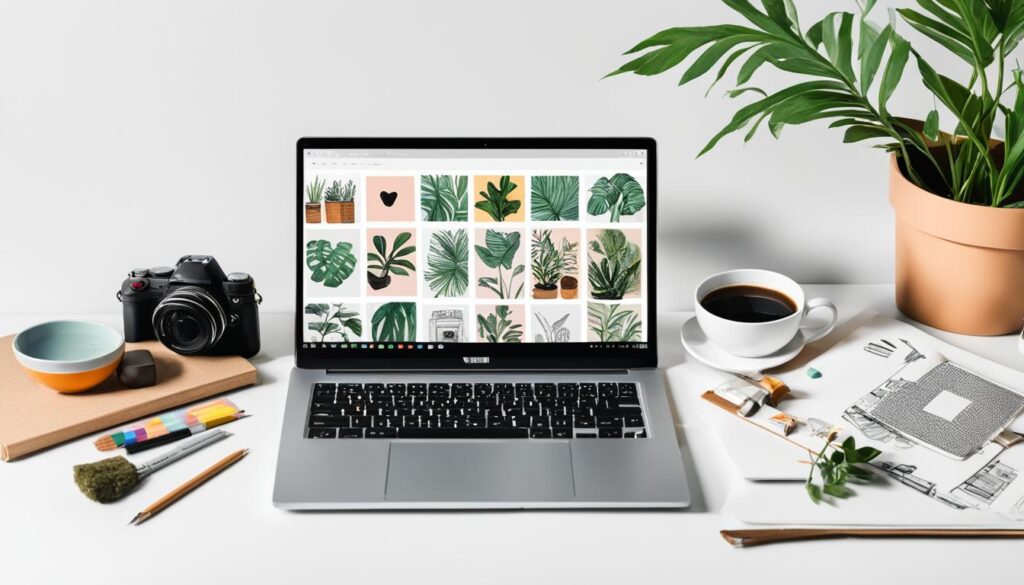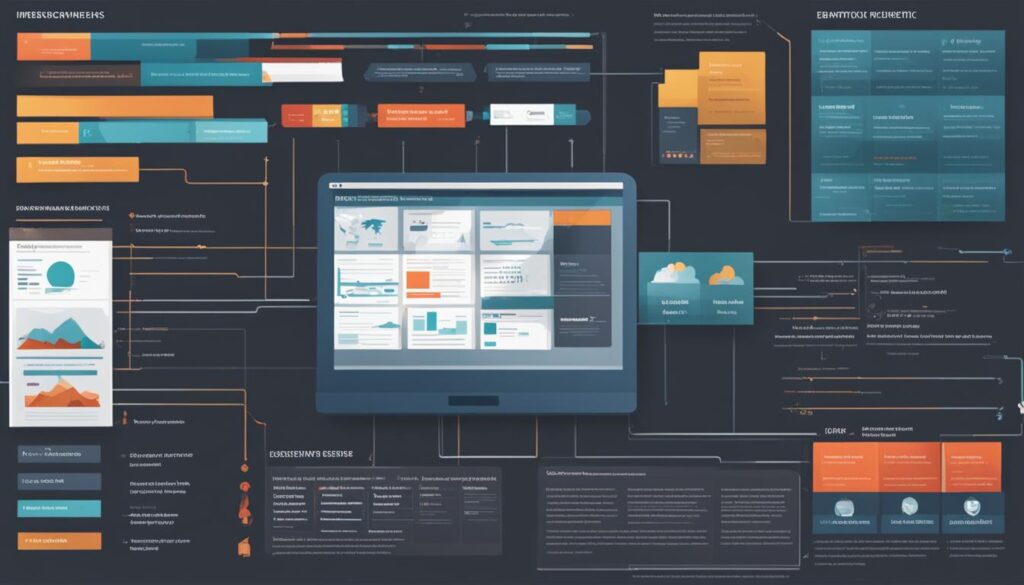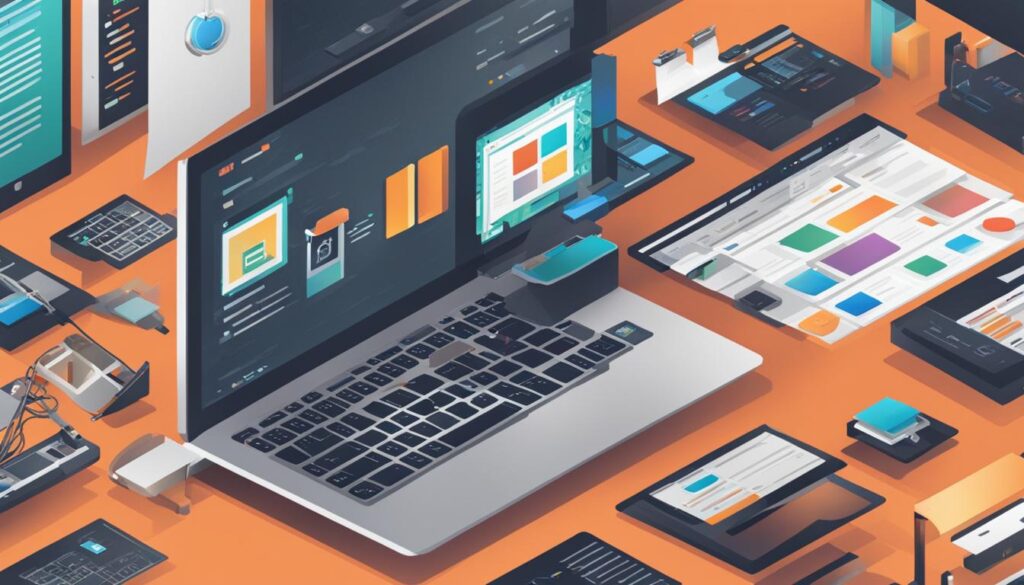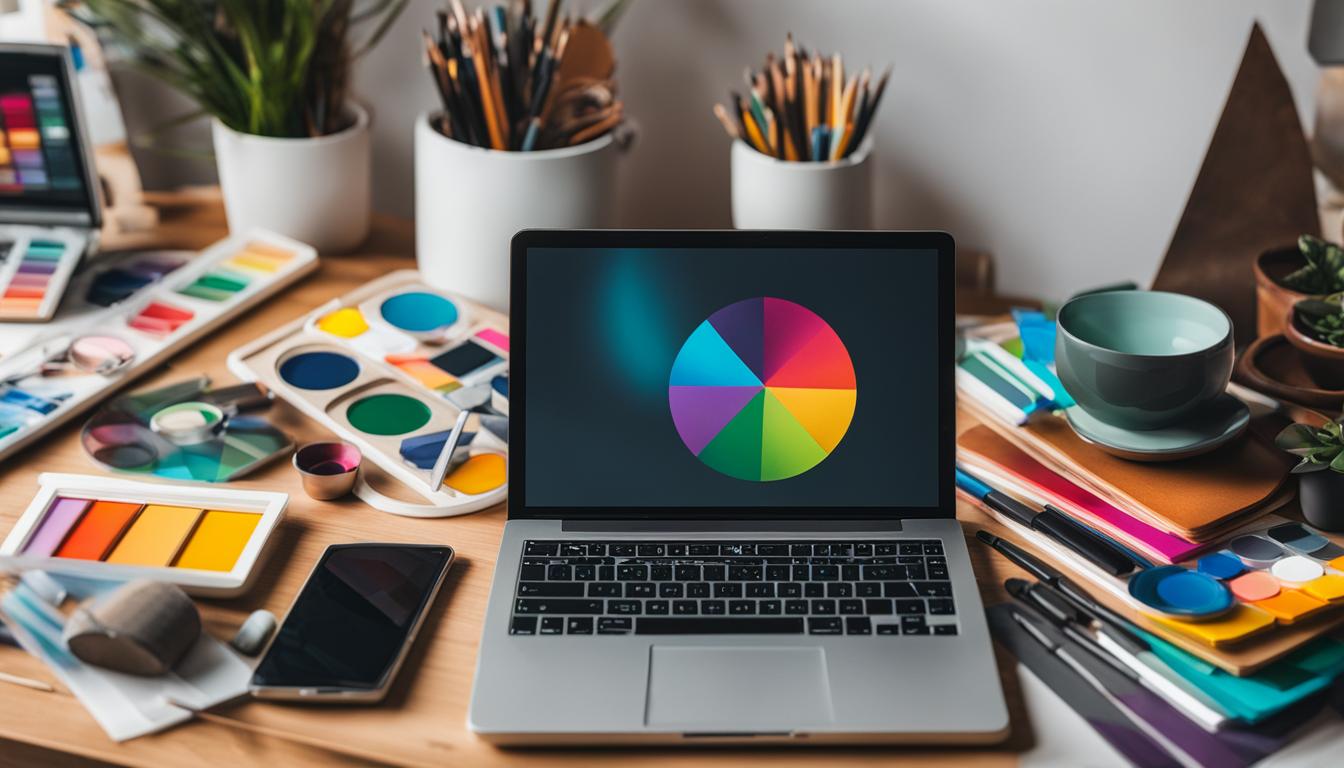Welcome to our beginner’s guide to starting web design! If you’re new to web design and looking for guidance on how to get started, you’ve come to the right place. In this guide, we’ll provide you with essential tips, tutorials, and a comprehensive overview of web design for beginners.
Web design plays a critical role in web development, shaping the visual appeal and user experience of websites. Whether you’re interested in crafting stunning designs or creating user-friendly interfaces, this guide will equip you with the knowledge and techniques to kickstart your web design journey.
From understanding the basics to developing design skills and focusing on the user experience, we’ll cover all the essential aspects of web design. By the end of this guide, you’ll have the foundation needed to create visually appealing and user-friendly websites.
Key Takeaways:
- Learn the basics of web design to kickstart your journey.
- Choose a simple project for your first website design.
- Explore various sources of inspiration to fuel your creative process.
- Develop your design skills by understanding layout, visual hierarchy, and more.
- Put content first and design around it to create a cohesive user experience.
Choosing Your First Site Design
When starting out in web design, it’s important to choose a basic project that is simple and fun. By selecting a project that aligns with your interests, you’ll stay motivated and enjoy the learning process. One beginner-friendly option is creating a blog where you can share your thoughts, experiences, or expertise. Another idea is to showcase your hobbies or create a portfolio website to exhibit your work.
A helpful approach for beginners is to use website templates as a starting point. Templates provide a foundation with pre-designed layouts and styles, allowing you to focus on making changes and customizations to suit your needs. This way, you can learn the basics of web design while experimenting with different elements and techniques.
Here is an example of a basic template to get you started:
Template Name: Simple Blog Template
Description: This template features a clean and minimalistic design, perfect for beginners. It includes a homepage, blog post layout, and contact page. The simple layout allows for easy navigation and readability. Customize the colors, fonts, and images to reflect your personal style.
Key Features of the Template:
- Clean and minimalistic design
- Easy navigation and readability
- Homepage, blog post layout, and contact page
- Customizable colors, fonts, and images
Starting with a simple project and utilizing templates will help you grasp the basic web design principles and techniques necessary for website design. Remember to have fun and experiment with different elements to enhance your beginner-friendly web design skills.
Finding Inspiration for Your Designs

When it comes to web design, finding inspiration is essential to create visually appealing and engaging websites. Here are some valuable tips and tricks to help you discover inspiration and elevate your design skills as a beginner:
1. Create an Inspiration Doc
Start by creating an inspiration document where you can collect links to websites that you love. This document will serve as your personal library of design ideas and references. By curating a collection of inspiring websites, you can explore different styles, layouts, and navigation techniques that resonate with you.
For beginner web designers, it’s important to focus on websites that are visually appealing yet achievable. Look for designs that align with your skill level, and gradually work towards more complex designs as you gain experience.
2. Explore Curated Collections
There are several curated collections and design communities that showcase outstanding web design examples. Platforms like Awwwards, Behance, Dribbble, and Webflow Showcase feature handpicked designs from talented designers around the world. Take the time to explore these galleries, analyze the elements that make these designs stand out, and draw inspiration from them.
3. Look Beyond the Web
Don’t limit your sources of inspiration to the digital realm. Look for inspiration in other art forms such as graphic novels, art history, or even natural landscapes. These mediums can spark your creativity and offer a fresh perspective on design concepts.
4. Pay Attention to Typography
Typography plays a crucial role in web design. Experiment with different font combinations and pay attention to how typography contributes to the overall aesthetic and readability of a website. Explore various typefaces and learn how to use them effectively to enhance your designs.
5. Study Different Design Types
Expand your creative senses by studying different types of design beyond web design. Explore the world of graphic design, product design, and illustration to gain insights into composition, color theory, and visual storytelling. Drawing inspiration from different design disciplines can help you bring fresh ideas and unique perspectives to your web designs.
Remember, finding inspiration is the first step towards creating exceptional web designs. Collect ideas, analyze successful designs, and let your creativity flow as you embark on your web design journey.
Now let’s take a look at a curated table of popular web design resources and platforms:
| Platform | Description |
|---|---|
| Awwwards | A platform that recognizes and awards exceptional website designs |
| Behance | A creative platform where designers can showcase their work |
| Dribbble | A community of designers sharing their work and providing feedback |
| Webflow Showcase | A collection of websites built using the Webflow platform |
Developing Design Skills
To cultivate essential web design skills, it’s crucial to understand the web design principles and web design basics. By mastering the fundamentals, you’ll be equipped with the knowledge needed to create visually appealing and user-friendly websites. Here are some key areas to focus on:
Layout Design and Grid Systems
An effective layout design is the foundation of a well-structured website. Utilizing a grid system helps to create a consistent and balanced layout. Grids enable you to organize elements on a webpage, ensuring visual harmony and enhancing user experience.
Principles of Visual Design
The principles of visual design play a vital role in web design. By understanding concepts such as scale, visual hierarchy, balance, contrast, and gestalt, you can create visually engaging websites that effectively communicate your message.
Exploring Different Design Types
Expand your creative sensibilities by exploring various design types beyond web design. Delve into disciplines like product design and illustration. Studying these diverse design areas will enrich your creative toolkit and inspire fresh ideas for your web projects.
By focusing on these aspects, you can enhance your web design skills and create impactful websites that engage and delight users.
| Skills | Description |
|---|---|
| Layout Design | Master the art of organizing webpage elements and creating visually balanced layouts using grid systems. |
| Visual Design Principles | Understand the principles of scale, visual hierarchy, balance, contrast, and gestalt to create visually appealing websites. |
| Exploring Design Types | Expand your creative horizons by exploring different design disciplines like product design and illustration. |
Putting Content First

Before you embark on the design process for your website, it’s crucial to prioritize content development. By having your content ready beforehand, you’ll be better equipped to create a cohesive and engaging user experience. Planning and organizing your website’s content is the first step towards creating a successful and impactful web presence.
Website Content Planning
Effective website content planning involves understanding your target audience and aligning your content with their needs and expectations. By conducting thorough research, you can develop a clear understanding of your audience’s preferences, interests, and pain points. This knowledge will guide you in creating content that resonates with your visitors and encourages them to take the desired actions on your website.
Consider the following elements when planning your website’s content:
- Define your website’s goals and objectives to establish a clear direction for your content development.
- Create a content strategy that outlines the types of content you will produce and how they will align with your audience’s needs.
- Identify the key messages and value propositions that define your brand and incorporate them into your content.
- Develop a content calendar to help you stay organized and ensure a consistent flow of fresh content on your website.
By taking a strategic approach to content planning, you can ensure that your website’s content delivers value to your audience and supports your overall business objectives.
Web Content Development
Web content development involves creating and refining the actual content that will be featured on your website. It’s essential to produce high-quality, engaging, and relevant content that meets the needs of your target audience. Here are some tips to help you develop effective web content:
- Create a content outline to organize your ideas and ensure a logical flow throughout your website.
- Write compelling and concise copy that grabs the reader’s attention and communicates your message effectively.
- Use headlines, subheadings, and bullet points to break up text and make it easier to scan.
- Incorporate relevant keywords naturally into your content to improve search engine visibility.
- Avoid jargon and technical terms that may confuse or alienate your audience.
“Good content is not storytelling. It’s telling your story well.” – Ann Handley
Content-Driven Web Design
Content-driven web design places content at the forefront of the design process. By designing around the content rather than fitting the content into a pre-existing template, you can create a seamless and engaging user experience. Here are some key elements of content-driven web design:
- Wireframing: Begin the design process by creating wireframes that focus on the placement and layout of your content elements.
- Visual Hierarchy: Use typography, color, and spacing to guide the user’s attention to the most important content elements.
- Responsive Design: Ensure that your website’s design is responsive and adaptable to different screen sizes, optimizing the user experience across devices.
Designing your website with content in mind allows you to create a user-centric experience that effectively communicates your message and engages your audience. By putting content first, you can build a website that meets the needs of your users and achieves your business goals.
Designing for User Experience

User experience (UX) and user interface (UI) are integral to successful web design. At our web design agency, we understand the importance of creating designs that prioritize the needs and preferences of users. Let’s explore the key aspects of UX and UI and how they contribute to a seamless and engaging user experience.
The Basics of User Experience Design
UX design focuses on understanding your audience and tailoring your website to meet their needs. By conducting thorough user research, you can gain valuable insights into the preferences, behaviors, and goals of your target audience. This research allows you to create user personas and develop an in-depth understanding of your users.
By focusing on simplicity, intuitiveness, and clear communication, you can create a website that provides a seamless and engaging user experience.
With this knowledge, you can design intuitive navigation menus, clear calls to action, and user-friendly interfaces. A well-executed UX design ensures that users can easily find the information they need, navigate through the website effortlessly, and achieve their goals efficiently.
User Interface Design Basics
UI design complements UX by focusing on the visual and interactive aspects of the website. It involves creating engaging layouts, visually appealing elements, and easy-to-understand interfaces. UI design also involves selecting suitable colors, typography, and iconography that align with your brand image and evoke the desired emotional response from users.
“Good design is obvious. Great design is transparent.” – Joe Sparano
With an effective UI design, you can guide users through the website, highlight important features, and make interactions clear and intuitive. By paying attention to details such as button placements, visual hierarchy, and responsive design, you can enhance the overall user experience and leave a lasting impression on your visitors.
Importance of User Research for Web Design
Conducting user research is essential for creating a website that truly resonates with your target audience. It allows you to refine your design decisions and ensure that your website caters to the specific needs and preferences of your users. User research can be conducted through methods such as surveys, interviews, usability testing, and analyzing user behavior through web analytics.
By gaining insights from your target audience, you can make informed design choices, optimize user flows, and address any pain points or usability issues. User research is an ongoing process that enables continuous improvement and ensures that your website remains relevant and user-friendly.
Understanding Web Development Basics

In order to build a successful website, it is essential to have a solid understanding of web development basics. Web development encompasses various processes, including markup and coding, scripting, network configuration, and content management system (CMS) development. Familiarizing yourself with these fundamental concepts will empower you to create functional and visually appealing websites.
Web development consists of two main areas: front-end development and back-end development. Front-end development focuses on the elements that users interact with directly, such as the website design and user interface. It involves using HTML, CSS, and JavaScript to create engaging and responsive web pages that effectively communicate with the user.
On the other hand, back-end development is concerned with the behind-the-scenes functionality of a website. It involves server-side scripting, database management, and ensuring smooth data flow between the server and the client. Back-end developers work with programming languages like PHP, Python, and Ruby to bring websites to life.
In addition to front-end and back-end development, web development also involves network configuration, including server setup and management. This ensures that websites are accessible to users and perform optimally.
Furthermore, content management system (CMS) development plays a significant role in web development. A CMS allows you to efficiently manage and update your website’s content without extensive technical knowledge. Popular CMS platforms include WordPress, Drupal, and Joomla, which provide user-friendly interfaces and customizable templates.
To further demonstrate the importance of web development basics, below is a table summarizing the key components:
| Key Components | Description |
|---|---|
| Front-end development | Focuses on creating the user-facing elements of a website using HTML, CSS, and JavaScript. |
| Back-end development | Deals with server-side scripting, database management, and data communication between the server and the client. |
| Network configuration | Involves server setup and management to ensure the website is accessible and performs optimally. |
| Content management system (CMS) development | Enables efficient content management and updates without extensive technical knowledge using platforms like WordPress, Drupal, and Joomla. |
By understanding web development basics, you will have a solid foundation to embark on your web design journey and create impressive websites that meet both your clients’ and users’ needs.
Types of Web Development

In the world of web development, there are different specialties that professionals can choose to pursue. Understanding these different types of web development can help you determine your area of interest and specialization. Let’s take a closer look at three key categories: front-end development, back-end development, and full stack development.
Front-End Development
Front-end development focuses on the user-facing side of websites. It involves creating the visual elements and interactive features that users see and interact with. Front-end developers use HTML, CSS, and JavaScript to build the front-end structure, design, and functionality of a website. They ensure that the website is aesthetically pleasing, responsive, and user-friendly. Front-end developers also collaborate closely with designers to bring their vision to life.
Back-End Development
While front-end development focuses on the user experience, back-end development handles the server-side functionality of a website. Back-end developers work on the behind-the-scenes aspects that make a website work. They build and maintain the server, database, and application logic that enable the website to function properly. Back-end development involves working with server-side languages like PHP, Python, Ruby, and Java, as well as databases like MySQL and MongoDB. Back-end developers also ensure the security and performance of a website, optimizing it for speed and efficiency.
Full Stack Development
Full stack development encompasses both front-end and back-end development. Full stack developers have knowledge and experience in both areas, allowing them to work on all aspects of a website’s development. They can handle everything from creating the user interface to building the server-side components. Full stack developers are versatile and can work on different layers of the web development stack, including the client-side, server-side, and database. Their broad skillset enables them to take a project from start to finish, making them valuable assets in web development teams.
| Specialty | Description |
|---|---|
| Front-End Development | Focuses on the user-facing side of websites, creating the visual elements and interactive features. |
| Back-End Development | Handles the server-side functionality of a website, building and maintaining the server, database, and application logic. |
| Full Stack Development | Encompasses both front-end and back-end development, allowing developers to work on all aspects of a website’s development. |
Whether you’re passionate about creating visually stunning designs, building robust server-side systems, or handling all aspects of web development, there’s a path for you in web development. Knowing the different types of web development will help you decide where to focus your learning and development.
Conclusion
Starting web design as a beginner may seem daunting, but with the right guidance and practice, you can become a skilled web designer. At the core of your web design journey, remember these key tips and techniques for success.
Firstly, choose a simple project to begin your web design journey. This could be creating a blog or showcasing your hobbies. Starting with a basic project allows you to gain experience and learn how to work with a content management system (CMS).
Finding inspiration is also essential for web design. Explore websites you love and curated collections like Awwwards, Behance, Dribbble, and Webflow showcase. Additionally, look beyond the web for sources of inspiration, such as graphic novels or art history. Pay attention to typography and study different types of design to expand your creative senses.
To develop your design skills, understand the basics of web design principles such as layout design, grid systems, and the principles of visual design. Experiment with different types of design like product design and illustration to broaden your creative sensibilities.
Putting content first is vital in web design. Have your content ready before you start designing your website. Designing with real content helps you visualize how the website will look and function, allowing you to make necessary changes earlier in the design process.
Designing for user experience (UX) is crucial. Focus on simplicity, intuitiveness, and clear communication to create a seamless and engaging user experience. Conduct user research to understand your target audience and design accordingly.
Lastly, understanding the basics of web development is essential for web designers. Familiarize yourself with different aspects of web development and the specialties within it, such as front-end development, back-end development, and full stack development.
With these tips and techniques in mind, you’ll be well on your way to creating visually appealing and user-friendly websites. Keep learning and exploring different aspects of web design to continuously enhance your skills and stay up-to-date with the ever-evolving digital landscape.
FAQ
How do I choose my first site design?
When starting out in web design, it’s important to choose a basic project that is simple and fun. Consider creating a blog or showcasing your hobbies. Templates can be a valuable learning tool, providing a foundation for making changes and customizations. By starting with a simple project, you’ll gain experience and learn how to work with a content management system (CMS).
Where can I find inspiration for my designs?
Finding inspiration is essential for web design. Create an inspiration doc with links to websites you love and explore curated collections like Awwwards, Behance, Dribbble, and Webflow showcase. Look beyond the web for sources of inspiration, such as graphic novels or art history. Pay attention to typography and study different types of design to expand your creative senses.
How can I develop my design skills?
To cultivate your design skills, it’s important to understand the basics of web design. Learn about layout design and grid systems, as well as the principles of visual design, including scale, visual hierarchy, balance, contrast, and gestalt. Additionally, explore different types of design like product design and illustration to expand your creative sensibilities.
What should I consider when putting content first?
Before you start designing your website, it’s important to have content ready. This includes having a rough draft of the content that will go live on your website. Designing with real content will help you better visualize how the website will look and function, and it will allow you to make necessary changes earlier in the design process. For blogs, having a few posts written before launching will save you from scrambling to write content later.
How can I design for user experience?
User experience (UX) and user interface (UI) are crucial aspects of web design. UX focuses on understanding your audience and creating designs that meet their needs, while UI is about creating interactive elements and design layouts. By focusing on simplicity, intuitiveness, and clear communication, you can create a website that provides a seamless and engaging user experience. Conduct user research to gain insights into your target audience and design accordingly.
What are the basics of web development?
Web development encompasses the process of building a website, including markup and coding, scripting, network configuration, and content management system (CMS) development. It’s important to have a basic understanding of web development and the different aspects involved. From front-end development to back-end development, there are various specialties within web development that one can pursue.
What are the different types of web development?
Web development offers different specialties, such as front-end development, back-end development, and full-stack development. Front-end developers focus on the user-facing side of websites, while back-end developers handle the server-side functionality. Full-stack developers have knowledge of both front-end and back-end development. Understanding these different types of web development can help you determine your area of interest and specialization.
How can I start web design as a beginner?
Starting web design as a beginner may seem daunting, but with the right guidance and practice, you can become a skilled web designer. By choosing a simple project, finding inspiration, developing your design skills, putting content first, designing for user experience, and understanding the basics of web development, you’ll be well on your way to creating visually appealing and user-friendly websites. Remember to keep learning and exploring different aspects of web design to continuously enhance your skills.

Leave a Reply